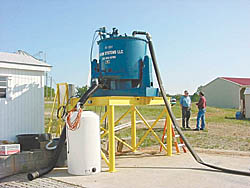
Why haul water to your fields when you can remove it before spreading manure, saving equipment expense, labor and, most importantly, fuel costs.
"My new system is ideal for farm use with rugged stainless steel construction," explains Kyte, who says his automatic system requires no operator and can be set up to handle fresh flushed manure or older lagoon sludge.
Kyte is now testing several units on dairy and hog farms and looking for more testers. The units are sized (and priced) for large operations. A TS-5000 is able to handle daily flush from eight 1,000-hog swine barns or 72,000 gal./day. Test units are available at 15 percent over cost as Kyte seeks more on-farm experience.
The TS-5000 consists of a 120-gal. (48-in. by 30-in.) bowl, which is fed at the rate of 50 gal./min. As it revolves at 1300 G, 80 to 85 percent of solids settle to the sidewalls, while water overflows the top of the bowl and drains away. There are no gearboxes, conveyers or differential moving parts.
Once the bowl is filled, the feed pump is shut off. A pneumatic knife/plow cuts the approximately 30 percent dry matter cake out of the bowl to fall free through spokes in the bottom of the bowl.
"The cake can be augured into a spreader truck or storage system at that point," says Kyte. "In swine manure tests at North Carolina State University (NCSU), the manure was quite warm the next day, and I believe it would compost quickly. Water from flushed barns is clean enough to be reused for further flushing."
In the NCSU tests, the TS-5000 successfully removed 80 percent of solids and 55 to 60 percent of phosphates without any chemicals being added. If polymer coagulants are added, solid removal rate can increase to 95 to 98 percent.
